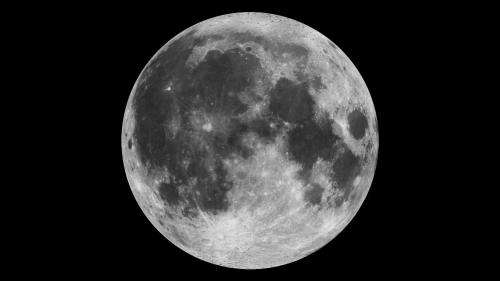May 7, 2013 report
New research sets back date of moon's dynamo 160 million years

(Phys.org) —A multi-disciplinary team of international researchers has found evidence to suggest the moon's dynamo persisted until at least 3.6 billion years ago. In their paper published in the Proceedings of the National Academy of Sciences, the team says this pushes back the date for the dynamo approximately 160 million years.
Currently, the moon has no global magnetic field, but analysis of rocks brought back by Apollo astronauts showed that it did at one time. To create such a field, the moon would necessarily have had some churning in its interior—a dynamo. Evidence of a dynamo inside the moon has led scientists to propose different theories as to how it might have come about. Some suggest it might have been due to an impact that knocked the internals loose and set them moving for a period of time. Others theorize it might have been more likely due to differences in heat distribution during radioactive decay, prompting liquid shifting.
To gain a better understanding of the moon's dynamo and how it might have occurred, researchers have been working to more clearly define when it came about, how strong it was and how long it lasted. To that end, researchers with this latest effort went back to the moon rocks that started the whole debate. Using newer technology to analyze the rocks, they found that they had, on average, fields of 13–70 microtesla—the higher readings are on a par with that of Earth's magnetic field. More importantly, they found that the rocks showed that a dynamo existed as far back as 3.6 billion years ago.
This new finding, the researchers say, shoots down the idea of the dynamo forming due to a large impact. That's because other research has shown that no impacts large enough to cause a dynamo have occurred since approximately 3.72 billion years ago—well before the age of the samples found. But that still doesn't reveal the actual cause.
Though they can't prove it, the group suggests the dynamo mostly likely occurred due to interaction with Earth's gravity—likening it to a tug-of-war between the solid mantel and the liquid core, resulting in a constant internal churning.
More information: Persistence and origin of the lunar core dynamo, PNAS, Published online before print May 6, 2013, doi: 10.1073/pnas.1300341110
Abstract
The lifetime of the ancient lunar core dynamo has implications for its power source and the mechanism of field generation. Here, we report analyses of two 3.56-Gy-old mare basalts demonstrating that they were magnetized in a stable and surprisingly intense dynamo magnetic field of at least ∼13 μT. These data extend the known lifetime of the lunar dynamo by ∼160 My and indicate that the field was likely continuously active until well after the final large basin-forming impact. This likely excludes impact-driven changes in rotation rate as the source of the dynamo at this time in lunar history. Rather, our results require a persistent power source like precession of the lunar mantle or a compositional convection dynamo.
Journal information: Proceedings of the National Academy of Sciences
© 2013 Phys.org





















